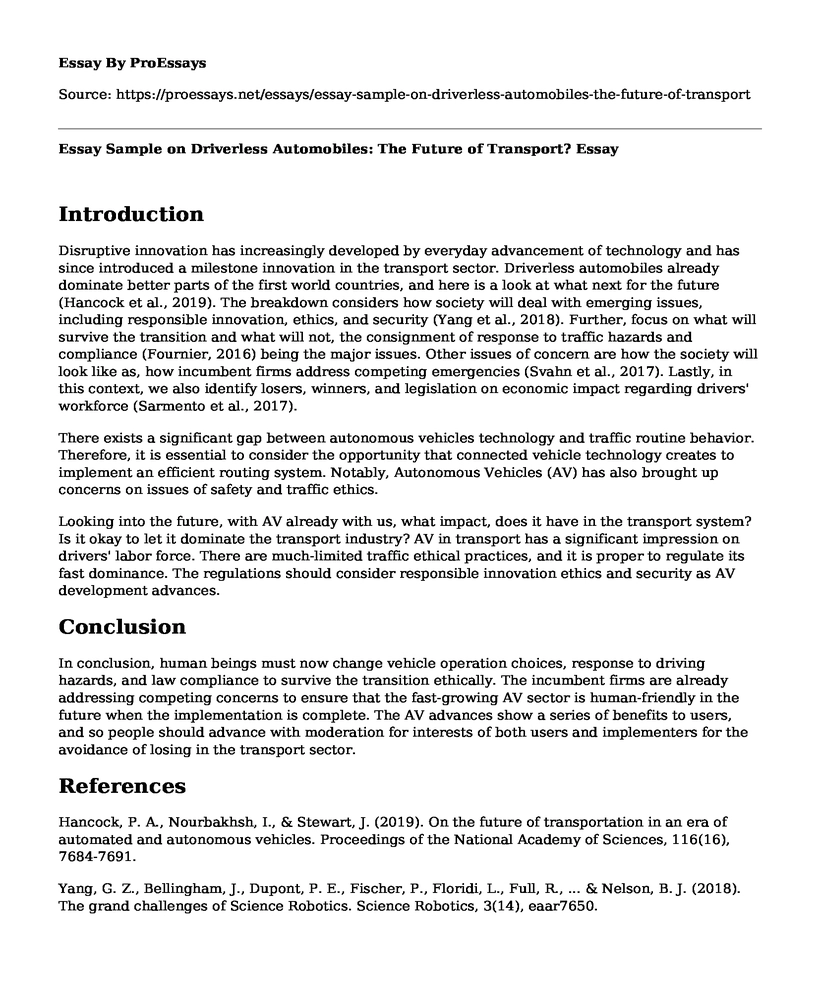Introduction
Disruptive innovation has increasingly developed by everyday advancement of technology and has since introduced a milestone innovation in the transport sector. Driverless automobiles already dominate better parts of the first world countries, and here is a look at what next for the future (Hancock et al., 2019). The breakdown considers how society will deal with emerging issues, including responsible innovation, ethics, and security (Yang et al., 2018). Further, focus on what will survive the transition and what will not, the consignment of response to traffic hazards and compliance (Fournier, 2016) being the major issues. Other issues of concern are how the society will look like as, how incumbent firms address competing emergencies (Svahn et al., 2017). Lastly, in this context, we also identify losers, winners, and legislation on economic impact regarding drivers' workforce (Sarmento et al., 2017).
There exists a significant gap between autonomous vehicles technology and traffic routine behavior. Therefore, it is essential to consider the opportunity that connected vehicle technology creates to implement an efficient routing system. Notably, Autonomous Vehicles (AV) has also brought up concerns on issues of safety and traffic ethics.
Looking into the future, with AV already with us, what impact, does it have in the transport system? Is it okay to let it dominate the transport industry? AV in transport has a significant impression on drivers' labor force. There are much-limited traffic ethical practices, and it is proper to regulate its fast dominance. The regulations should consider responsible innovation ethics and security as AV development advances.
Conclusion
In conclusion, human beings must now change vehicle operation choices, response to driving hazards, and law compliance to survive the transition ethically. The incumbent firms are already addressing competing concerns to ensure that the fast-growing AV sector is human-friendly in the future when the implementation is complete. The AV advances show a series of benefits to users, and so people should advance with moderation for interests of both users and implementers for the avoidance of losing in the transport sector.
References
Hancock, P. A., Nourbakhsh, I., & Stewart, J. (2019). On the future of transportation in an era of automated and autonomous vehicles. Proceedings of the National Academy of Sciences, 116(16), 7684-7691.
Yang, G. Z., Bellingham, J., Dupont, P. E., Fischer, P., Floridi, L., Full, R., ... & Nelson, B. J. (2018). The grand challenges of Science Robotics. Science Robotics, 3(14), eaar7650.
Fournier, T. (2016). Will my next car be a libertarian or a utilitarian?: Who will decide?. IEEE Technology and Society Magazine, 35(2), 40-45.
Svahn, F., Mathiassen, L., & Lindgren, R. (2017). Embracing Digital Innovation in Incumbent Firms: How Volvo Cars Managed Competing Concerns. Mis Quarterly, 41(1).
Sarmento, A., Garcia, B., Coriteac, L., & Navarenho, L. (2017). The autonomous vehicle challenges for a new market (No. 2017-36-0436). SAE Technical Paper.
Cite this page
Essay Sample on Driverless Automobiles: The Future of Transport?. (2023, Feb 12). Retrieved from https://proessays.net/essays/essay-sample-on-driverless-automobiles-the-future-of-transport
If you are the original author of this essay and no longer wish to have it published on the ProEssays website, please click below to request its removal:
- Student Observing a Bus Paper Example
- Essay Sample on Crowded Bust Stop: Overcrowding Amidst Abundance
- Paper Example on Interconnected World: Exploring the Impact of IoT
- Essay on Social Media: Enhancing Fire Dept. Operations in the Digital Age
- Gault's Arrest: Police Ignored Legal Procedure & Parental Consent - Case Study
- Paper Sample on Cybersecurity in the UAE: Analyzing Threats, Techniques, Solutions
- Free Essay Example: Recycling in the United States







